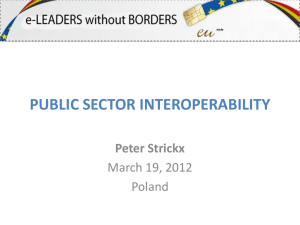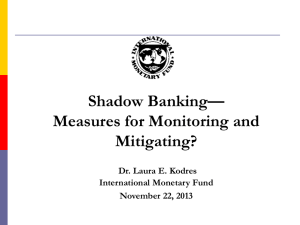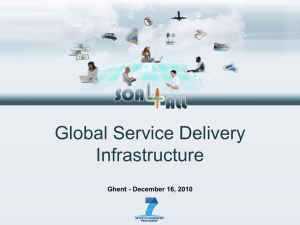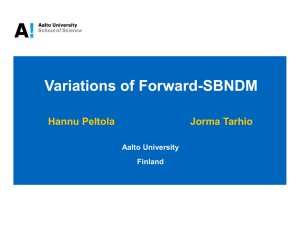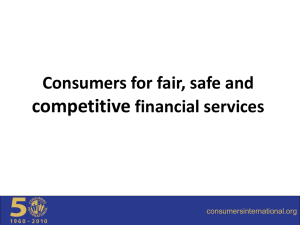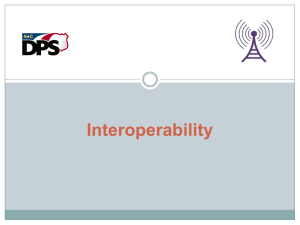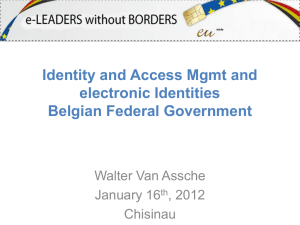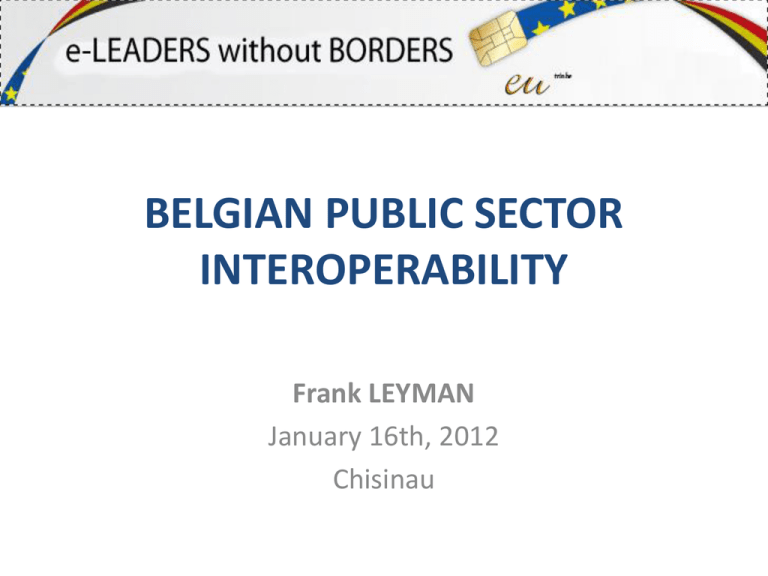
BELGIAN PUBLIC SECTOR
INTEROPERABILITY
Frank LEYMAN
January 16th, 2012
Chisinau
Agenda
• General e-Government context
• Belgian interoperability implementation (FSB)
• European Interoperability framework (ISA)
E-Government
•
“E-government focuses on better services for citizens and
businesses and more effective use of the Government’s
information resources. It sets a strategic direction for the
way the public sector will transform itself by implementing
business models which exploit the possibilities of new
technology”
Office of the e-Envoy (UK - 2002)
E-Government
“Putting lipstick on a bulldog”
• Multiple FPS
• Multiple Regions
• Multiple technologies
• Back-Office integration
© Fedict 2009. All rights reserved | p. 5
e-gov guiding principles
Total Solution (integrated services)
“I will say it only once” – Authoritative [Data] Source (even
between governments) – limit admin. formalities
Customer focus / User friendly
Transparent & Respect for Privacy
No digital divide (channel neutral)
Minimal cost / reliable / available / performance
How to manage Public Sector Data?
• Every FPS to manage its own data
• Only authoritative sources
– Liability
– Quality
• Access via HUB’s
–
–
–
–
HUB Fedict (Federal Service Bus)
HUB CBSS (Social Security)
HUB eHealth
…
Authoritative Source Management
MANAGE
COLLECTION
Create
Update
Delete
MANAGE
HISTORY
& QUALITY
MANAGE
DISCLOSURE
Read
Federal Back-office infrastructure
Rules of the Game
• Respect of:
– Proportionality
– Finality
• Political Management:
– Ministers
• Technical & Operational Management:
– Fedict in collaboration with ICT of the FPS’s (=> PICTS)
• Data Privacy Management:
– Privacy Commission
DATA CONSUMER
PRIVACY
COMMISSION
ACCESS
RIGHT
HUB
ACCESS
RIGHT
DATA PROVIDER
How to setup a services catalogue
that is appealing to society?
• Convert all products/tools into services
• Add:
– Detailed Service description
– Practical info on:
• Where to order – how to install – what cost - …
– SLA
– Service desk
LEGAL
SERVICE MGNT
SUPPORT
MAINTENANCE
IT
FAS
ROLE MANAGEMENT
MAGMA
WCMS
Fast2Web
eLOKET
ePAYMENT
ONLINE APPLICATIONS
FSB
DIGIFLOW
APPLICATION INTEGRATION
MIDDLEWARE
FEDMAN
VAM
CERTIFICATE
PKI
DSS
INFRASTRUCTURE
I
A
M
BELGIAN INTEROPERABILITY
IMPLEMENTATION
(FSB)
e-gov architecture
Identity and Acces Management
Security environment
Citizens
Access & Application environment
portal
Authoritative Sources
Transactional environment :
–
FSB
–
Authorative sources
Transaction Environment
RRN
Enterpriss
Network Environment
LOCAL
GOVERNMENTS
COMMUNITY
REGION
Federal Metropolitan Area Network (FedMAN)
SPP / POD
(Fedman)
Civil
servants
SPF / FOD
Network environment
Other Authorities & Institutions
Acces & application environment
Security & Privacy
Introducing FSB
Introducing FSB
Fedict’s answer:
Service Oriented Architecture
(SOA);
the
Federal
Service
Bus
Supplier
Supplier
Consumer
Supplier
FSB approach : Open Approach
WEB Application
WEB Application
security + trust
Federal Service Bus
Regional or
Local SB
FEDMAN
Federal Authentic sources
Local or Regional Authentic sources
FSB concept : Fedict facilitates access to
Authoritative sources via web services and FSB
Notary
FSB
• Federal Service Bus
• One unique
connection to
different back-ends
• Secured access
RN
XML
Web
XML
RBis
FSB Governance
Catalogue of FSB Services
Service Architects
Service Managers
Service
Providers
& Consumers
SOA governance and management applications
Taxonomy & information management
Service lifecycle management
Service discovery
SOA conformance
Service publication / advertising /
promotion
Service connection guidance
Policy establishment & management
Reporting
Change & impact analysis
Service / usage reporting
Service Registry / Repository
Service due diligence
Service request & registration
FSB Services
Reusable services
Person Services
Enterprise Services
Get information from different registers (National register and
Social Security)
Combine these into a useful business service
ConsultKBO
Different specialized services
Application specific services
E-depot
4th way
E-birth
…
Advantages of this SOA approach
One Stop Shopping
Standardize services
Reduce connection points (and points of failure)
Standard security, logging, monitoring
Common data model
Standardized behavior
Governance
Release management
Staging
Loose coupling
Europe : proposed service taxonomy
FSB use cases : PersonService
Task services
Entity services
Utility services
Rijksregister
Get
Person
service
Search
Person
service
NREntity
service
NR
access
service
Manage
Person
service
Social Security
Consumers
Person
Legacy
service
SSREntity
service
SSR
access
service
FSB use cases : PersonService
Task services
Entity services
Utility services
Rijksregister
Get
Person
service
Search
Person
service
NREntity
service
NR
access
service
Manage
Person
service
Social Security
Consumers
Person
Legacy
service
Composed
public
service
SSREntity
service
Basic logic
service
SSR
access
service
Basic data
service
FSB use cases : eDepot
Objective : Create a Belgian Company in 3 days (1 day for eDepot)
PersonServices
Access
Authentic
Sources
Enterprise Services
Notary fills a digital deed using data
coming from the authentic sources
Maximum 1 day
Create & Activate Entreprise
eDepot
The notary electronically signs the document,
and securely submits it to the eDepot services
Deposit digital deed to Justice
Workflow
Send Abstracts to
Monitor for publication
Few Minutes later, the notary receives a company number
> The client can use this number to start his activities
FSB use cases : eDepot
Objective : Create a Belgian Company in 3 days (1 day for eDepot)
PersonServices
Access
Authentic
Sources
Life event
Enterprise Services
Notary fills a digital deed using data
coming from the authentic sources
Maximum 1 day
Create & Activate Entreprise
eDepot
The notary electronically signs the document,
and securely submits it to the eDepot services
Deposit digital deed to Justice
Workflow
Few Minutes later, the notary receives a company number
> The client can use this number to start his activities
Process
Public
Service
Send Abstracts to
Monitor for publication
Basic logic
service
FSB use cases : Police-on-Web
FSB use cases : eBirth
RRN
eLoket
Police
Back end
FSB use cases : Police-on-Web
FSB use cases : eBirth
RRN
Basic logic
service
eLoket
Police
Back end
FSB use cases : eBirth
Hospital
eHealth
National Register
Munipality
of residence
Social Security
Munipality
place of birth
logic
FSB use cases :Basic
eBirth
service
Hospital
Life event
eHealth
National Register
Munipality
of residence
Process
Public
Service
Social Security
Munipality
place of birth
Conclusion : the taxonomy works for us
Life event
Process
Public
Service
Composed
public
service
Basic data
service
Basic logic
service
EUROPEAN INTEROPERABILITY
INITIATIVES
(ISA)
What is Interoperability?
In the ISA context, interoperability means the
facilitation of cross-border and cross-sector
information exchange, taking into account legal,
organisational, semantic and technical aspects.
IDABC EIF
• European Interoperability Framework
• 3 dimensions :
– Organisational Interoperability
– Semantic Interoperability
– Technical Interoperability
The Trend
• European public administrations provide more
and more of their services online to
businesses and citizens.
• The Single Market enables citizens and
businesses to move, work, travel and study
freely within the EU.
• This requires increased collaboration between
European public administrations to settle the
associated formalities.
The Vision
Efficient and effective electronic cross-border
and cross-sector interaction between European
public administrations.
– share and reuse existing successful eGovernment
solutions
– Flexible and interlinked IT systems allow smooth
implementation of Community policies and
activities.
The contribution of the ISA program
• Providing an architectural framework for the seamless
exchange of information between IT systems of
Member States: Development of guidelines and
methodologies for cross- border ICT solutions.
• Fostering development of generic tools and services
which can be used by all public administrations.
• Industrialisation of existing infrastructure service
components and tools for generalised reuse.
• Pooling of resources across the Member States
through the coordination, exchange of experiences
and good practices.
KEY PRINCIPLES
STAKEHOLDERS
BENEFICIARIES
• Directly
–
–
–
–
National public administrations from Member States,
Candidate Countries,
Countries of the European Economic Area,
Third countries (but their costs are not covered).
– Regional and local administrations
– The services of the European Commission
• Indirectly
– European businesses and citizens (profiting from a more
efficient delivery of public services).
The ISA activities
EU pilots that work on
cross-border interoperability
© fedict 2011. All rights reserved
Overview of LSP’s Collaborations
Transport
Infrastructure
Company ID
Citizen ID
Transport
Infrastructure
Company
Dossier
Citizen ID
Transport
Infrastructure
Citizen ID
Company ID
Company
Dossier
Citizen ID
Privacy
Privacy
Frank LEYMAN
Frank.leyman@fedict.be
http://www.fedict.be




